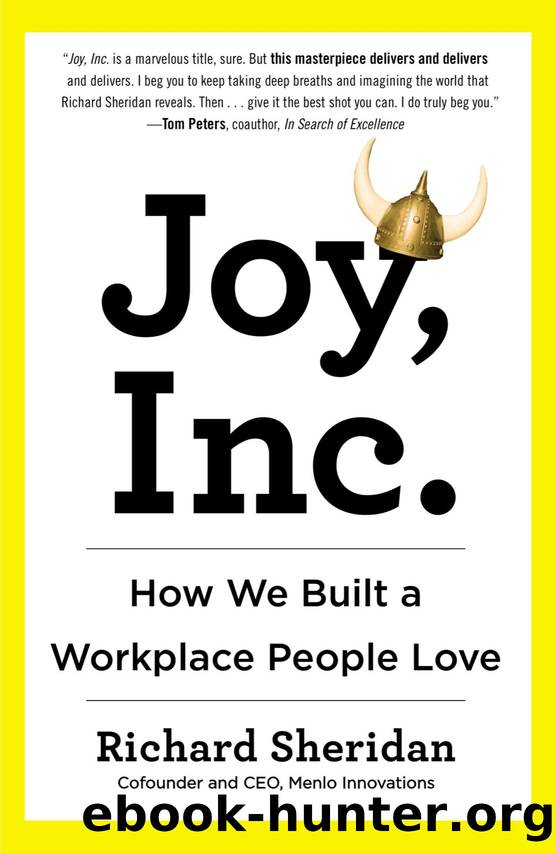Joy, Inc. by Richard Sheridan

Author:Richard Sheridan
Language: eng
Format: epub
Publisher: Penguin Publishing Group
Published: 2015-01-19T16:00:00+00:00
Experiment: Planning Origami
During the Java Factory days at Interface Systems, we made a lot of improvements in overall productivity, quality, and speed, yet we were still not able to constrain the requirements in a tangible way that allowed us to hit our budget and time frames. I started paying more attention to the product manager who worked with us every other week to set priorities, and I noticed something subtle. He was always requesting an excess of forty hours of estimated work per resource on my team. I knew this wasnât sustainable.
âOh, itâs just one more little thing,â he would say, in a slightly high-pitched, whiny way. I told him I would be happy to tell my team they were now on fifty-hour workweeks, but he assured me he didnât want my team working more. He just wanted them to get more done.
In many projects, one of the deadliest challenges is scope creep. The easiest way to describe scope creep is that itâs the infamous addition of âItâs just one more little thing,â often brought up in hallway conversations by people who donât have to do the work. Add in enough âjust one more thingâsâ and voilà ! The deadline is missed and the project is over budget. Most Dilbert comics emanate from scope creep, typically initiated by the pointy-haired boss.
James suggested we run an experiment to combat this particular product managerâs scope creep and plan how we would use our forty hours each week. He recommended folding photocopies of the task cards to the size of the estimate for that task. A 5½-by-8½-inch copy would mean that that task card would require sixteen hours of work. That same card folded in half would mean eight hours would be needed for that task. This card folded in half again would indicate four hours, and one more fold, two hours. A thirty-two-hour card would be taped to a full-size sheet of paper, making it twice as big as a sixteen-hour card. Easy to create, easy to understand.
We then created tabloid-size planning sheets with an inscribed box that could hold forty hoursâ worth of folded cards. Our product manager picked up the folded cards and placed them inside the inscribed box. He could place up to forty hours of task card time on the sheetâbut no more. This puzzle was simple enough that the product manager, after using the system for just a few weeks, seldom asked for âjust one more thing.â When he did, we asked him what he would like to remove to make enough room for the new card. He didnât necessarily like it, but this experiment stopped scope creep in its tracks.
Most of our experiments at Menlo look something like this project planning origami experiment: simple, inexpensive, and fast. Many experiments donât survive for very long because they donât solve the problem. Some are only needed temporarily; others start as temporary and become permanent. We think many are amazing solutions to long-standing problems when, in reality, they last for a little while and then change or go away.
Download
This site does not store any files on its server. We only index and link to content provided by other sites. Please contact the content providers to delete copyright contents if any and email us, we'll remove relevant links or contents immediately.
AI Native Enterprise: The Leader's Guide to AI-Powered Business Transformation by Yi Zhou(274)
Challengers: How a New Breed of Leaders Collaborates and Wins in a Hyper Competitive World by Ben-Attar Saar(268)
Time is Now: A Journey Into Demystifying AI by Raj Verma(233)
Stoic at Work by Annie Lawson(219)
Change Management that Sticks by Barb Grant(205)
Leadership Team Alignment by Frédéric Godart(190)
Impact with Love: Building Business for a Better World by Greg Harmeyer(188)
Startups Grow With People by Dagdeviren Ozan(172)
Reconstructing Inclusion by Amri B. Johnson(168)
People and Data by Redman Thomas C.;(168)
Leading and Managing Change in the Age of Disruption and Artificial Intelligence by Donald Mathew;(163)
You're Too Smart for This : (Beating the 100 Big Lies About Your First Job) by Michael Ball(162)
Corporate Fraud Exposed by Baker H. Kent;Purda Lynnette;Saadi Samir;(158)
9 Powerful Practices of Really Great Teams by Stephen E. Kohn(157)
How to Speak Human by Jackson Dougal;Jackson Jennifer;(150)
Change Your Business with NLP by Lindsey Agness(148)
The Executive Warrior by Ng Victor;(145)
Leadership Transitions by Richard Elsner(140)
Outpacer by Alex Holt(139)
